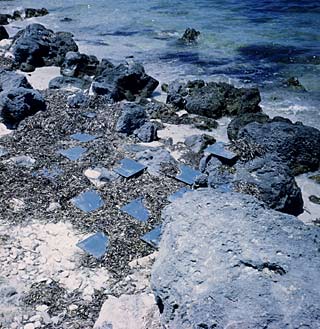|
 |
 |



|

Yucatan Mirror Displacements (1–9), 1969 (detail). Nine chromogenic-development slides. Solomon R. Guggenheim Museum, Purchased with funds contributed by the Photography Committee and with funds contributed by the International Director's Council and Executive Committee Members. 99.5269. © Estate of Robert Smithson/Licensed by VAGA, New York, NY. |
 |
 |
As much as the activities of mapping, measuring, digging, pouring, mirroring, and writing were essential components of Robert Smithson's art practice, the act of photographing was equally fundamental to his aesthetic. During a trip to Mexico in 1969, he created the Yucatan Mirror Displacements (1–9) by installing twelve-inch square mirrors on sites dispersed throughout the peninsula and photographing the different arrangements. The resulting series of nine color photographs was published in Artforum that same year to accompany Smithson's essay "Incidents of Mirror-Travel in the Yucatan," a hallucinatory travelogue in which he described the displacements as "memory traces." The mirrors reflected and refracted the surrounding environs, visually disrupting the solidity of the landscape and shattering its forms. Part Earthwork and part image, the displacements contemplate temporality; while the mirrors record the passage of time (and reveal elements beyond the camera lens), the photographs suspend time.
|
|















